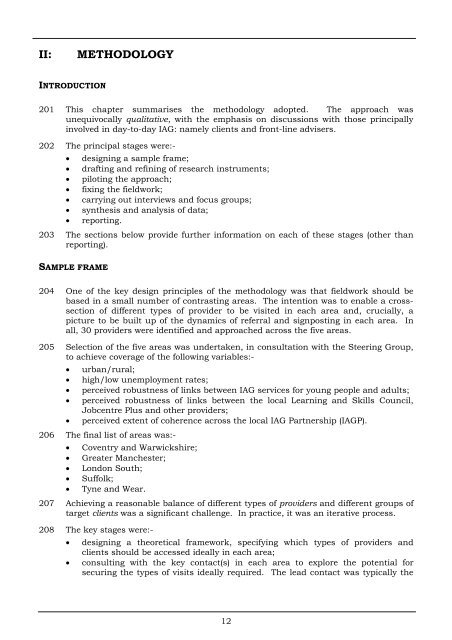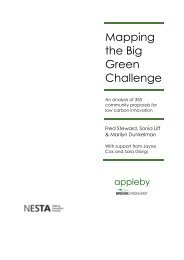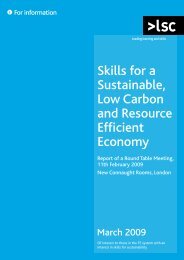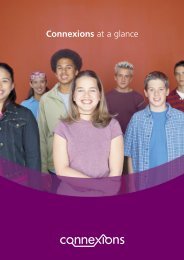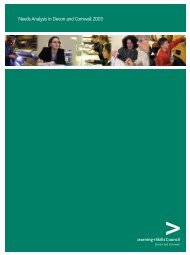Client needs for coherent information, advice and guidance services ...
Client needs for coherent information, advice and guidance services ...
Client needs for coherent information, advice and guidance services ...
Create successful ePaper yourself
Turn your PDF publications into a flip-book with our unique Google optimized e-Paper software.
II:<br />
METHODOLOGY<br />
INTRODUCTION<br />
201 This chapter summarises the methodology adopted. The approach was<br />
unequivocally qualitative, with the emphasis on discussions with those principally<br />
involved in day-to-day IAG: namely clients <strong>and</strong> front-line advisers.<br />
202 The principal stages were:-<br />
• designing a sample frame;<br />
• drafting <strong>and</strong> refining of research instruments;<br />
• piloting the approach;<br />
• fixing the fieldwork;<br />
• carrying out interviews <strong>and</strong> focus groups;<br />
• synthesis <strong>and</strong> analysis of data;<br />
• reporting.<br />
203 The sections below provide further in<strong>for</strong>mation on each of these stages (other than<br />
reporting).<br />
SAMPLE FRAME<br />
204 One of the key design principles of the methodology was that fieldwork should be<br />
based in a small number of contrasting areas. The intention was to enable a crosssection<br />
of different types of provider to be visited in each area <strong>and</strong>, crucially, a<br />
picture to be built up of the dynamics of referral <strong>and</strong> signposting in each area. In<br />
all, 30 providers were identified <strong>and</strong> approached across the five areas.<br />
205 Selection of the five areas was undertaken, in consultation with the Steering Group,<br />
to achieve coverage of the following variables:-<br />
• urban/rural;<br />
• high/low unemployment rates;<br />
• perceived robustness of links between IAG <strong>services</strong> <strong>for</strong> young people <strong>and</strong> adults;<br />
• perceived robustness of links between the local Learning <strong>and</strong> Skills Council,<br />
Jobcentre Plus <strong>and</strong> other providers;<br />
• perceived extent of coherence across the local IAG Partnership (IAGP).<br />
206 The final list of areas was:-<br />
• Coventry <strong>and</strong> Warwickshire;<br />
• Greater Manchester;<br />
• London South;<br />
• Suffolk;<br />
• Tyne <strong>and</strong> Wear.<br />
207 Achieving a reasonable balance of different types of providers <strong>and</strong> different groups of<br />
target clients was a significant challenge. In practice, it was an iterative process.<br />
208 The key stages were:-<br />
• designing a theoretical framework, specifying which types of providers <strong>and</strong><br />
clients should be accessed ideally in each area;<br />
• consulting with the key contact(s) in each area to explore the potential <strong>for</strong><br />
securing the types of visits ideally required. The lead contact was typically the<br />
12


